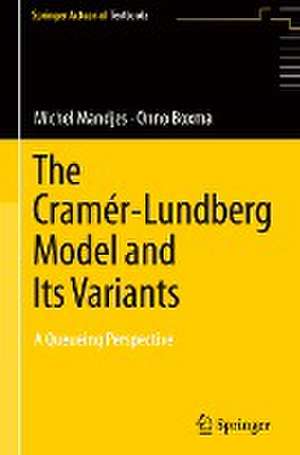The Cramér–Lundberg Model and Its Variants: A Queueing Perspective: Springer Actuarial
Autor Michel Mandjes, Onno Boxmaen Limba Engleză Hardback – 28 noi 2023
Providing a systematic and self-contained approach to evaluate the crucial quantities found in the Cramér–Lundberg model, the book makes use of connections with related queueing models when appropriate, and its emphasis on clean transform-based techniques sets it apart from other works. In addition to consolidating a wealth of existing results, the book also derives several new outcomes using the same methodology.
This material is complemented by a thoughtfully chosen collection of exercises. The book's primary target audience is master's and starting PhD students in applied mathematics, operations research, and actuarial science, although it also serves as a useful methodological resource for more advanced researchers. The material is self-contained, requiring only a basic grounding in probability theory and some knowledge of transform techniques.
Preț: 503.70 lei
Preț vechi: 592.59 lei
-15% Nou
Puncte Express: 756
Preț estimativ în valută:
96.39€ • 100.03$ • 80.57£
96.39€ • 100.03$ • 80.57£
Carte tipărită la comandă
Livrare economică 17-31 martie
Preluare comenzi: 021 569.72.76
Specificații
ISBN-13: 9783031391040
ISBN-10: 3031391047
Pagini: 246
Ilustrații: XI, 246 p. 31 illus.
Dimensiuni: 155 x 235 mm
Greutate: 0.54 kg
Ediția:1st ed. 2023
Editura: Springer Nature Switzerland
Colecția Springer
Seriile Springer Actuarial, Springer Actuarial Textbooks
Locul publicării:Cham, Switzerland
ISBN-10: 3031391047
Pagini: 246
Ilustrații: XI, 246 p. 31 illus.
Dimensiuni: 155 x 235 mm
Greutate: 0.54 kg
Ediția:1st ed. 2023
Editura: Springer Nature Switzerland
Colecția Springer
Seriile Springer Actuarial, Springer Actuarial Textbooks
Locul publicării:Cham, Switzerland
Cuprins
- 1. Cramér-Lundberg Model. - 2. Asymptotics. - 3. Regime Switching. - 4. Interest and Two-Sided Jumps. - 5. Threshold-Based Net Cumulative Claim Process. - 6. Level-Dependent Dynamics. - 7. Multivariate Ruin. - 8. Arrival Processes with Clustering. - 9. Dependence Between Claim Sizes and Interarrival Times. - 10. Advanced Bankruptcy Concepts.
Notă biografică
Michel Mandjes is a full professor at the Mathematical Institute of Leiden University, with a part-time appointment at the Korteweg-de Vries Institute for Mathematics of the University of Amsterdam. His previous employers include KPN Research, Bell Laboratories, the University of Twente, and CWI. His research focuses on stochastic processes and their applications in actuarial sciences and operations research.
Onno Boxma is Professor of Stochastic Operations Research in the Department of Mathematics and Computer Science of Eindhoven University of Technology. His main research interests are in queueing theory and its applications to the performance analysis of computer-, communication-, production- and traffic systems, and in insurance risk.
Textul de pe ultima copertă
This book offers a comprehensive examination of the Cramér–Lundberg model, which is the most extensively researched model in ruin theory. It covers the fundamental dynamics of an insurance company's surplus level in great detail, presenting a thorough analysis of the ruin probability and related measures for both the standard model and its variants.
Providing a systematic and self-contained approach to evaluate the crucial quantities found in the Cramér–Lundberg model, the book makes use of connections with related queueing models when appropriate, and its emphasis on clean transform-based techniques sets it apart from other works. In addition to consolidating a wealth of existing results, the book also derives several new outcomes using the same methodology.
This material is complemented by a thoughtfully chosen collection of exercises. The book's primary target audience is master's and starting PhD students in applied mathematics, operations research, and actuarial science, although it also serves as a useful methodological resource for more advanced researchers. The material is self-contained, requiring only a basic grounding in probability theory and some knowledge of transform techniques.
Caracteristici
Provides unified framework which systematically exploits the relation to queueing theory Emphasizes various variants of the classical Cramér–Lundberg setup with applications to insurance risk Includes carefully selected exercises to master the material












